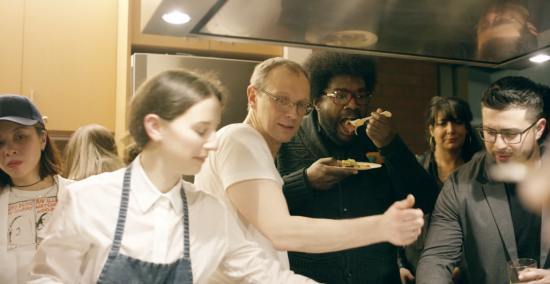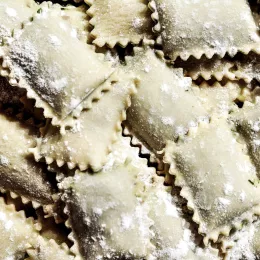Chef Bill Telepan’s bio reads like a culinary best-seller. He’s the executive chef of the bustling midtown restaurant, Oceana; executive chef of Wellness in the Schools, a national nonprofit devoted to healthy eating in public schools; he enjoyed a 10-year run as chef-owner of a Michelin-starred farm-to-table restaurant; he was even invited by Michelle Obama to join the Chefs Move to Schools task force. Chef Telepan cares as much about what’s on the plate as where it comes from, whether he’s cooking for his own children or an über-exclusive dinner hosted by Questlove.
With so many achievements, why is this chef going back to culinary school? Because he’s stepping into a brand new role as ICE’s new Director of Sustainability, a role in which he’ll help develop a sustainability-focused curriculum for the next generation of chefs. In Chef Telepan’s words, “Sustainability is important to teach culinary students because they are our future food leaders.” Not only will he contribute to the teaching side of ICE, he’ll also have the chance to learn how to grow herbs and produce in ICE’s indoor hydroponic farm. ICE is thrilled to welcome Chef Telepan into our community, and in anticipation, we caught up with him to chat about urban farming, food waste and teaching culinary students about sustainability.

How do you incorporate sustainability into your daily work as executive chef at Oceana?
From the beginning, I knew I wanted to work with local farms because fresher produce means better flavor. And if you get produce from farms, it lasts longer because you’re basically buying produce from the ground. As time went on, I realized how important farms were to the environment, which made me want to support them even more. At Oceana, I can have a tiny impact on the oceans. I hope to be able to work with fishermen and women on using lesser-known fish and being less detrimental to the waters. As far as waste, chefs naturally think about waste because of costs. I’ve always thought about how to incorporate every part of a product into our menus. It’s not easy because most customers want familiar ingredients like the center cut. But I’m slowly seeing the needle move in the right direction on this issue.
You’re also executive chef for Wellness in the Schools — tell me about your path to working with nutrition and education.
I’ve always thought about eating well and good nutrition. But I became more aware of it when I became a father. I wanted my children to eat well and when my children started going to school, I became curious about what was being served. It wasn't until I met Nancy Easton, the founder of Wellness in the Schools, that I found an opportunity to help. There are many, many children who don't have the means to eat well outside of school. Schools have the ability to bring nutritious, real food to students, as well as educate them on healthy food and cooking. I got involved back when [the organization was] in just three schools in New York City — and now we’re in 125 schools nationwide, reaching 60,000 children a day. We are helping kids get a healthy lunch and teaching cooking and nutrition lessons that they’ll have for the rest of their lives.
As a culinary school graduate yourself, why do you think it's important to teach culinary students about sustainability?
Sustainability is important to teach culinary students because they are our future food leaders. They are the ones who are going to dictate what food should be produced, how it's produced and the effects it has on the environment. They need to learn about proper farming practices and waste. They need to know what foods are good for us. They need to understand all of this so they can teach, direct and become a force of good for the planet.

What do you see as the biggest challenge for restaurants in terms of sustainability?
Money. Space. Time. Education. These are the factors that restaurants need to consider in order to run sustainably. We want to buy from farmers, producers and fisheries that are producing their product properly. But since poorly raised food has become so cheap, it's more expensive to buy right. Space is an issue because it's hard to set up composting and recycling in busy restaurants. But I know that restaurant owners and chefs are finding ways to do it. Time and education go together. It takes time to educate your staff on the proper procedures, know why you're doing them and having them execute it properly.
More and more restaurants are focusing on minimizing food waste — is this the future of restaurants?
Like I said before, chefs are conditioned not to waste. But now we are thinking about it on a different level. We are utilizing things that we may have thrown out in the past, and not just in the kitchen — we’re seeing this at the restaurant bar, too.
Urban agriculture is on the rise — how is this affecting the food industry?
Urban farming is so smart. I mean, think about all the rooftop gardens in NYC alone! We chefs are excited about it because it gets us closer to the food source, and that means our products are as fresh as possible. We are going to have to feed a lot of people in the future so it is a very opportune time for this movement to be happening.
What are you hoping to learn from working in ICE’s hydroponic farm?
A lot: I’m excited to get involved not just to learn about farming, but also for the teaching opportunities — to use the hydroponic garden for taste lessons, and to choose to grow different products that aren't normally taught in the school. I’m excited to work with the instructors to see what they want to grow and to create lessons together. It’s a great opportunity for me to see what we can teach future students and chefs.
Ready to study culinary arts alongside leading chefs like Bill Telepan? Click here to learn more about ICE’s career programs.




